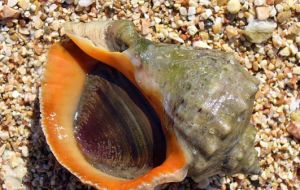MercoPress. South Atlantic News Agency
Invasive Asian mollusc advances along Argentine coast threatening food chain
 The voracious Rapana Venosa, slowly moving along the South Atlantic coast
The voracious Rapana Venosa, slowly moving along the South Atlantic coast An invasive Asian mollusc, Rapana Venosa, is rapidly expanding along the Argentine coastline threatening local ecosystems and fishing activities according to Argentine marine biologists from the National Council for Scientific and Technical Research, Conicet.
Originally from China it is believed to have arrived in Argentina and possibly Uruguay in the mid nineties in the ballast water of so many vessels that trade with Asia and begun feeding on local species thus cracking the natural sea food chain along the South Atlantic coast.
“The Asian mollusc is here, it’s strongly established and there is no way of eliminating it so far” admits Diego Giberto an Rapana Venosa expert from Conicet.
Highly adaptable and fertile it was first discovered in the River Plate in 1998 and not long after it had multiplied and extended along the coast of the Buenos Aires province, reaching close to Mar del Plata, Argentina’s fishing capital.
With no natural predators the voracious Asian mollusc which rapidly adapted to the new habitat has become a threat to the bivalves, clams, mussels, oysters, as well as the fish that feed on them.
“Although we still lack sufficient data to confirm it, taking into account the speed with which it is developing and what it feeds on, it can become a serious threat for fisheries”, said Giberto who also works with colleagues from Inidep, the National Institute for Fisheries Research and Development.
Silently the Asian mollusc is also expanding along the Uruguayan coast where the Marine Biology Department from the University was rewarding with money all those specimens delivered dead of alive.
Rapana Venosa which has also become an undesired guest for Italy, France and even the United States forced the collapse of several mussel exploitations in the Black Sea, where fishermen ended up catching the invasive species and exporting them to China where it has a solid market.
“Coastal fishing is one of the ideas we are working with” to exploit these colonies, said Giberto who revealed that Inidep is testing with traps to capture them in the River Plate as well as along the Atlantic coast of Argentina.
“It’s an alternative for fishermen” pointed out Giberto who admits that the species is so established in the region that it is ‘more practical’ to learn to live with it than trying to eradicate.




Top Comments
Disclaimer & comment rules-

-

Read all commentsI'm no specialist, but if one of the readers has a connection with authorities, I believe that finding a killer disease of these molluscs is a must. If found, then innoculation of specimens caught alive and their subsequent release in different places along the coast to spread the disease will (hopefully) serve more to their control that any ocean-scraping nets. Cheers!
Aug 09th, 2011 - 01:30 pm 01 Argie (#) Remember what happened in Australia when they decided to infect the imported rabbit plague with Myxomatosis. It might be best to learn to live with the problem of the molluscs as suggested.
Aug 11th, 2011 - 01:39 am 0Commenting for this story is now closed.
If you have a Facebook account, become a fan and comment on our Facebook Page!